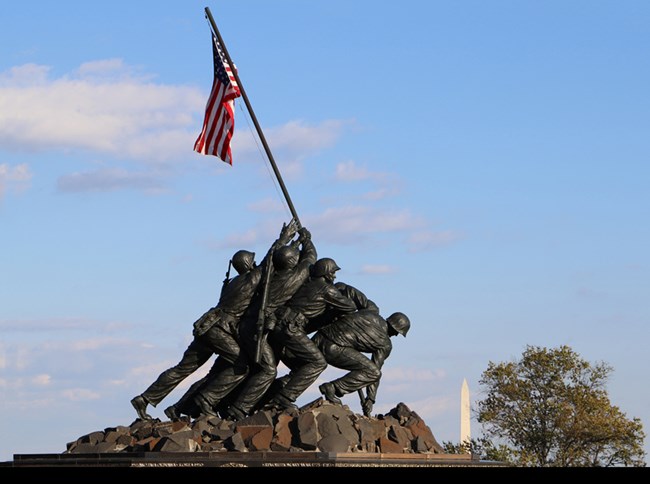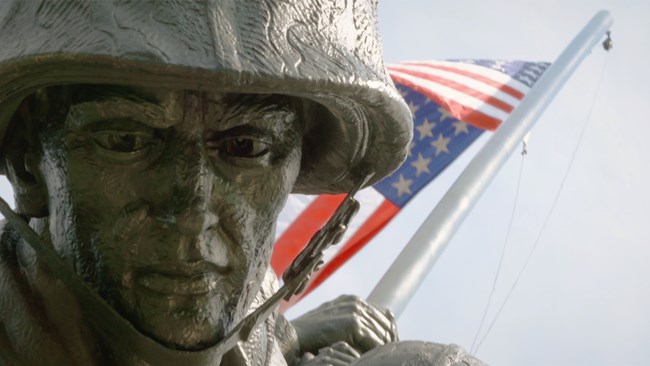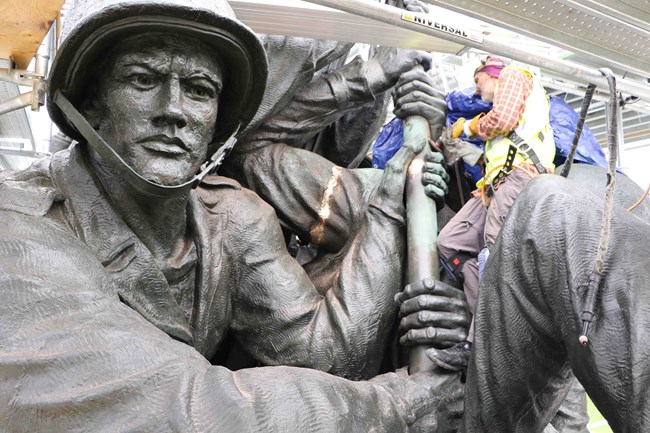When Was Th Korean War Memorial Opened Who Designed the National Museum of African Art
"In accolade and in memory of the men of the United states Marine Corps who have given their lives to their country since Nov ten, 1775."
The United States Marine Corps War Memorial represents this nation's gratitude to Marines and those who take fought beside them. While the statue depicts one of the most famous incidents of World War II, the memorial is defended to all Marines who have given their lives in defense of the United States since 1775.

Visit the Marine Corps War Memorial
Program your visit to the Marine Corps War Memorial. Find directions and information nearly hours, fees, and things to do.
The Motion-picture show behind the Statue
The tiny island of Iwo Jima lies 660 miles south of Tokyo. Mountain Suribachi, an extinct volcano that forms the narrow southern tip of the isle, rises 550 anxiety to dominate the sea around it. US troops had recaptured nigh of the other islands in the Pacific Ocean that the Japanese had taken in 1941 and 1942. In 1945 Iwo Jima became a primary objective in American plans to bring the Pacific campaign to a successful conclusion.
On the morn of Feb 19, 1945, the quaternary and 5th Marine Divisions invaded Iwo Jima afterward an ineffective 72-hour bombardment. The 28th Regiment of the 5th Sectionalization, was ordered to capture Mount Suribachi. They reached the base of the mountain on the afternoon of February 21 and, by nightfall the adjacent twenty-four hour period, had nearly completely surrounded it. On the morning of February 23, Marines of Visitor E, 2nd Battalion, started the tortuous climb upwards the rough terrain to the top. At about x:30 am men all over the island were thrilled by the sight of a pocket-sized American flag flying from atop Mount Suribachi. That afternoon, when the slopes were clear of enemy resistance, a 2d, larger flag was raised in the aforementioned location.
Making of a Memorial
Joe Rosenthal of the Associated Printing defenseless the afternoon flag-raising in an iconic photo that eventually won a Pulitzer Prize. Sculptor Felix West. de Weldon, then on duty with the United states Navy, was so moved by the image that he constructed outset a scale model and then a life-size model of it. Rene Gagnon, Ira Hayes, and John Bradley posed for the sculptor as he modeled their faces in clay. These three men were believed to be the survivors of the famous flag raising (the others were killed on Iwo Jima). The U.s.a. Marine Corps has since concluded that John Bradley was not in the famous image of the flag raising. To learn more virtually the identities of the flag raisers, delight read the Usa Marine Corps statement on the Iwo Jima flag raisers. All available pictures and physical statistics of the iii who had given their lives were collected then used in the modeling of their faces.
Once the statue was completed in plaster, it was carefully disassembled and trucked to Brooklyn, N.Y., for casting in bronze. The casting process, which required the work of experienced artisans, took nigh 3 years. After the parts had been cast, cleaned, finished, and chased, they were reassembled into approximately a dozen pieces--the largest weighing more than 20 tons--and brought back to Washington, D.C., by a 3-truck convoy. Here they were bolted and welded together, and the statue was treated with preservatives.
President Dwight D. Eisenhower dedicated the memorial in a ceremony on November 10, 1954, the 179th ceremony of the U.S. Marine Corps.
Memorial Statistics
30-ii foot high figures are shown raising a 60-foot bronze flagpole. The flag flies 24 hours a day, 365 days a yr by presidential proclamation.
The figures in the statue occupy the same positions every bit they were identified at the time in Rosenthal's celebrated photograph. Ira Hayes is the figure uttermost from the flagpole with both hands reaching up. Franklin Sousley is in front end of Hayes, to the right. John Bradley is in forepart of Sousley. Michael Strank is in front of Hayes, to the left. Rene Gagnon is in front of Strank. Harlon Block is at the pes of the flagpole. These were the men believed to take been the actual flag raisers when de Weldon created the statue. Since then, the U.s. Marine Corps has concluded that John Bradley was not in the iconic photograph. Researchers discovered that Harold Schultz was in actually in Sousley'due south position and Soulsley was in Bradley'southward position. To learn more you tin can read the U.s.a. Marine Corps's statement on the Iwo Jima flag raisers.
The M-l rifle and the carbine carried by two of the figures are sixteen and 12 feet long, respectively. The canteen would hold 32 quarts of water.
The figures stand on a rock slope above a granite base of operations. The unabridged memorial is about 78 feet alpine.
Granite for the base came from Sweden. The names and dates of every principal Marine Corps engagement since the founding of the Corps form a gold band effectually the base of operations.
The entire cost of the statue ($850,000) was donated by Us Marines, friends of the Marine Corps, and members of the Naval Service. No public funds were used for this memorial.

NPS Paradigm
Picket two videos that briefly explain the history and significance of the US Marine Corps State of war Memorial. The videos are able to be downloaded and used during your visit to the memorial.

Learn About the Recent Rehabilitation of the US Marine Corps State of war Memorial
Visit our rehabilitation page to see data, photos and videos of the contempo 2016 - 2020 rehabilitation project that occurred at the US Marine Corps State of war Memorial.
Source: https://www.nps.gov/gwmp/learn/historyculture/usmcwarmemorial.htm
Belum ada Komentar untuk "When Was Th Korean War Memorial Opened Who Designed the National Museum of African Art"
Posting Komentar